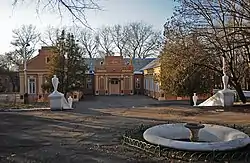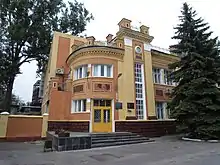New York
Нью-Йорк | |
|---|---|
| Niu-York | |
| Ukrainian transcription(s) | |
| • National | Niu-York |
| • ALA-LC | Nʹi͡u-Ĭork |
| • BGN/PCGN | N’yu-York |
| • Scholarly | Nʹju-Jork |
 The center of the settlement | |
 Coat of arms | |
| Coordinates: 48°19′55″N 37°50′11″E / 48.33194°N 37.83639°E | |
| Country | |
| Oblast | Donetsk Oblast |
| Raion | Bakhmut Raion |
| Hromada | Toretsk urban hromada |
| Founded | 1892 |
| Government | |
| • Type | Toretsk urban rada |
| Elevation | 106 m (348 ft) |
| Population (2022) | |
| • Total | 9,735 |
| Time zone | UTC+2 (EET) |
| • Summer (DST) | UTC+3 (EEST) |
| Postal code | 85297 |
| Area code | +380 6247 |
| KOATUU code | 1411246500 |
New York[1] or Niu-York[2] (Ukrainian: Нью-Йорк, IPA: [nʲjʊ ˈjɔ̈rk]; Russian: Нью-Йорк, romanized: Nyu-York) is an urban-type settlement in Toretsk urban hromada, Bakhmut Raion, Donetsk Oblast, eastern Ukraine. It is located 37.9 kilometres (23.5 mi) north-northeast from the centre of the city of Donetsk. From 1951 to 2021, the settlement was named Novhorodske (Ukrainian: Но́вгородське; Russian: Новгородское, romanized: Novgorodskoye).[3][4]
New York is administratively designated to Toretsk urban hromada, one of the hromadas of Ukraine with its center in the city of Toretsk, that is located about 10 kilometres (6.2 mi) north of New York. Population: 9,735 (2022 estimate).[5]
History
Pre-founding
The discovery of stone tombs in mounds proves that some human settlement dates back to the Bronze Age. However, the region is made of some arid steppe and various populations did not settle en masse. The current south-east of Ukraine has long been called "Wild Fields".
At the end of the 18th century, Catherine the Great completed the Russian conquest of the region. She built new towns and founded the Novorossiya Governorate. Catherine and her successors invited German settlers, especially Mennonites, to develop the conquered lands. After the destruction of the Sich in 1775, Zaporozhian Cossacks and mercenaries from the Balkans also settled in the region in order to secure the steps of the empire. In the 1830s, Tsar Nicholas I donated a vast territory to the count Pavel Nikolayevich Ignatiev. The way the region developed is not known.
Founding and name origin
The origin of the name of the town remains a mystery that is the subject of many local legends. It could come from an entrepreneur or local dignitary, who would have settled from the United States or who would have had as a partner an American citizen from New York City.[6] Another explanation refers to the city of Jork, currently in northern Germany, where Mennonite settlers may have come from. The local historian Viktor Kovalov thus believes that the name of the locality may have corresponded to "Neu Jork" (new Jork) and evolved over time. It may also be the result of a transliteration error from the Latin alphabet to the Cyrillic alphabet.[7] However, the establishment of the Mennonites officially dates back to 1889, whereas the name Niu-York predates it. Another track recalls that names with a famous evocation were frequent in the region in the 19th century. Historical maps show a "Swiss farm" near Druzhkivka or a hamlet called "Carthage" around Soledar.[8] Also, historian Viktor Kovalov does not rule out the possibility of a joke.[6]
New York first appeared on maps in 1846.[9] The first official mention of the name of New York (Нью-Йорк) dates back to 1859 as one of the results of the census of the Yekaterinoslav Governorate, then part of the Russian Empire. The 1859 census confirmed that the locality then had 13 households, 45 men, 40 women and a factory.[9]
Development in the 19th and 20th century
In 1889, Mennonites from the colony of Chortitza (today Zaporizhzhia) acquired a piece of land and founded a factory. Named after its owner and chief engineer, Jakob Niebuhr, it was completed in 1894. In 1892, Mennonites formed the colony of New York from seven settlements.[10][11] The industrialization of New York was accompanied by the construction of a north-south railway line. At the turn of the 20th century, the colony had electricity, a telegraph, a bank, a hotel, a bookstore, a school for girls and for boys.[7]
In 1916, New York was chosen to host a new naphthalene production plant. Despite the revolution of February 1917, the factory came into operation in July 1917. In the context of rising tensions between the USSR and Nazi Germany that led to World War II, most Mennonite Germans were repatriated, expelled, imprisoned or shot.
New York was occupied by German troops from December 1941 to the fall of 1944. The Petrovsk Machinery Plant (formerly Niebuhr) was transported and rebuilt in Soviet Kazakhstan. The phenol plant was moved to the Moscow region. The two factories were relocated in New York after the conflict.
On October 19, 1951, in the context of the Cold War, an ukase (decree) of the Presidium of the Supreme Soviet of the Ukrainian Soviet Socialist Republic ordered the change of name to Novhorodske (literally translated as "new city").[12] In times during the soviet industrialization industry developed in the city, was completed and modernized The Dzerzhinsky phenol plant; was also built Novgorod Machine-Building Plant named after G.I. Petrovsky, after the collapse of the USSR it ceased to exist, workshops and other buildings were sold out; various production facilities were organized in some, others were mothballed; three workshops were dismantled for building materials.
Russo-Ukrainian War and restored interest in cultural heritage

As part of the war in Donbas, which began in mid-April 2014, New York was occupied by pro-Russian and Russian forces from early May to late July. The fighting caused civilian and military casualties. On November 8, 2016, a civilian was killed by shelling.[13] According to then-Mayor Mykola Lenko, 16 residents lost their lives between 2014 and 2021.[7]
During the war, the local authorities, together with citizen groups, undertook to restore the historical name of the locality. In the wave of name changes required by nationwide decommunization laws of 2015, the City Council validated the return to New York.[14][6] Regional and national authorities did not act on it for many years though. Among other reasons, it was because of the special status imposed on towns located in the war zone. In 2019, a former house of the German colony was restored and transformed into an exhibition, cultural and artistic hub.[15]
The request to change the name of the locality to New York that was submitted by the civil-military administration of Donetsk Oblast was finally approved by the Committee of the Ukrainian parliament on the organization of state power, local self-government, regional development and urban planning on 3 February 2021 (18 votes for and 1 against).[16][17] On July 1, 2021, the Ukrainian Parliament renamed the city to its original name New York.[18][11][19] The resolution was supported by 301 people's deputies; Yevgeniy Shevchenko was the sole MP who voted "against", 13 MPs from Servant of the People and 12 from Opposition Platform — For Life abstained).[3] The formal restoration of the city's name launched a wave of cultural events. On the initiative of the Ukrainian writer Victoria Amelina, whose husband had roots in the settlement, the first "Ukrainian New York literature festival" was held in October.[20] The "New York marathon", inspired by the American event, brought together several dozens of participants at the beginning of November.[21]
As part of the Russian invasion of Ukraine, the phenol factory was bombed on April 5, 2022. Many inhabitants were evacuated.[22] Another bombing of the plant occurred on 16 June 2023.[23]
On March 18, 2023, New York was hit by a Russian missile.[24]
Transportation
The phenol train station is New York's train station. It connects the town with Sloviansk in the north and with Donetsk in the south. The southern connection has been cut since 2014.
Demographics

Upon Ukraine's declaration of independence, New York's population was estimated at around 20,000 inhabitants.
In 2021, it was estimated at less than 10,000 inhabitants by local authorities.[7]
In 2022, most residents fled or were evacuated in the context of the Russian invasion of Ukraine.
Native language as of the Ukrainian Census of 2001:[25]
References
- ↑ "Лето в донбасском Нью-Йорке: не рай, но жить нужно". 25 July 2021.
- ↑ According to the Resolution 55 of the Cabinet of Ministers of Ukraine.
- 1 2 Parliament renames Novhorodske village in Donetsk region to New York, Ukrinform (1 July 2021)
- ↑ (in Ukrainian) People's deputies returned New York to Ukraine, Ukrayinska Pravda (1 July 2021)
- ↑ Чисельність наявного населення України на 1 січня 2022 [Number of Present Population of Ukraine, as of January 1, 2022] (PDF) (in Ukrainian and English). Kyiv: State Statistics Service of Ukraine. Archived (PDF) from the original on 4 July 2022.
- 1 2 3 Ackermann, Niels; Gobert, Sébastien. "The other New York: the small Ukrainian town fighting to recover its historic name". The Calvert Journal. Retrieved 23 February 2023.
- 1 2 3 4 Ackermann, Niels; Gobert, Sébastien (2021). New York, Ukraine (in French). Lausanne: Editions Noir sur Blanc. ISBN 978-2-88250-711-2.
- ↑ "Соледар "не для чайників": 3 факти про місто соляників, яких ви могли не знати". Вільне радіо. 3 November 2020. Retrieved 23 February 2023.
- 1 2 Spiski naselennych měst Rossijskoj Imperii, sostavlennye i izdavaemye Central'nym Statističeskim Komitetom Ministerstva Vnutrennych Děl (in Russian). Vul'f. 1863.
- ↑ (in Ukrainian) Our dear New York. As a village in the Donetsk region, it fights for attention and investment, Hromadske.TV (13 February 2021)
- 1 2 New York on Ukraine's frontline: parliament backs town's name change, Reuters (2 July 2021)
- ↑ "Нью-Йорк, з якого видно Горлівку. Німецьке селище в "сірій зоні" показує себе і свою історію - Новинарня". novynarnia.com (in Ukrainian). 20 June 2018. Retrieved 23 February 2023.
- ↑ "Сводные данные АТО – 09 ноября – Информационно-аналитический центр". Информационно-аналитический центр национальной безопасности Украины. 9 November 2016. Archived from the original on 9 November 2016. Retrieved 18 March 2023.
- ↑ "Як живеться Нью-Йорку в степу донецькому?". www.ukrinform.ua (in Ukrainian). 11 November 2019. Retrieved 23 February 2023.
- ↑ Донбас.Реалії; Горбатенко, Сергій (8 April 2021). "Самый активный поселок на фронте: на Донбассе открыли хаб в доме немецких магнатов". Радіо Свобода (in Ukrainian). Retrieved 23 February 2023.
- ↑ "Україні повернуть Нью-Йорк. Це підтримав комітет Ради". Українська правда (in Ukrainian). Retrieved 23 February 2023.
- ↑ (in Ukrainian) "The last step remains." The Council Committee supported the renaming of one of the settlements in the Donbas to New York, NV (magazine) (3 February 2021)
- ↑ "Ukrainian town renamed 'New York'".
- ↑ "Parliament renames Novhorodske village in Donetsk region to New York". www.ukrinform.net. July 2021. Retrieved 23 February 2023.
- ↑ Донбас.Реалії; Горбатенко, Сергій (5 October 2021). "По маршруту "Львов – Нью-Йорк": как литературный фестиваль прививал Донетчину от "русского мира"". Радіо Свобода (in Ukrainian). Retrieved 23 February 2023.
- ↑ Донбас.Реалії (8 November 2021). "Нью-Йоркський марафон вперше пробігли по лінії фронту". Радіо Свобода (in Ukrainian). Retrieved 23 February 2023.
- ↑ Слабінська, Юлія (20 February 2023). "Як відбувається евакуація людей з лінії фронту". Суспільне | Новини (in Ukrainian). Retrieved 23 February 2023.
- ↑ "РФ вдарила по фенольному заводу в Нью-Йорку на Донеччині – одному з найбільших у світі виробників коксохімічної продукції". 16 June 2023.
- ↑ Petrenko, Roman (18 March 2023). "Russian forces hit Ukrainian New-York with missile, causing destruction". Ukrainska Pravda. Retrieved 18 March 2023.
- ↑ Розподіл населення за рідною мовою на ukrcensus.gov.ua
Bibliography
- Sébastien Gobert (texts) and Niels Ackermann (pictures), New York, Ukraine. Guide d'une ville inattendue, éditions Noir sur blanc, 2021, 204 pages.
External links
 Media related to Niu-York at Wikimedia Commons
Media related to Niu-York at Wikimedia Commons